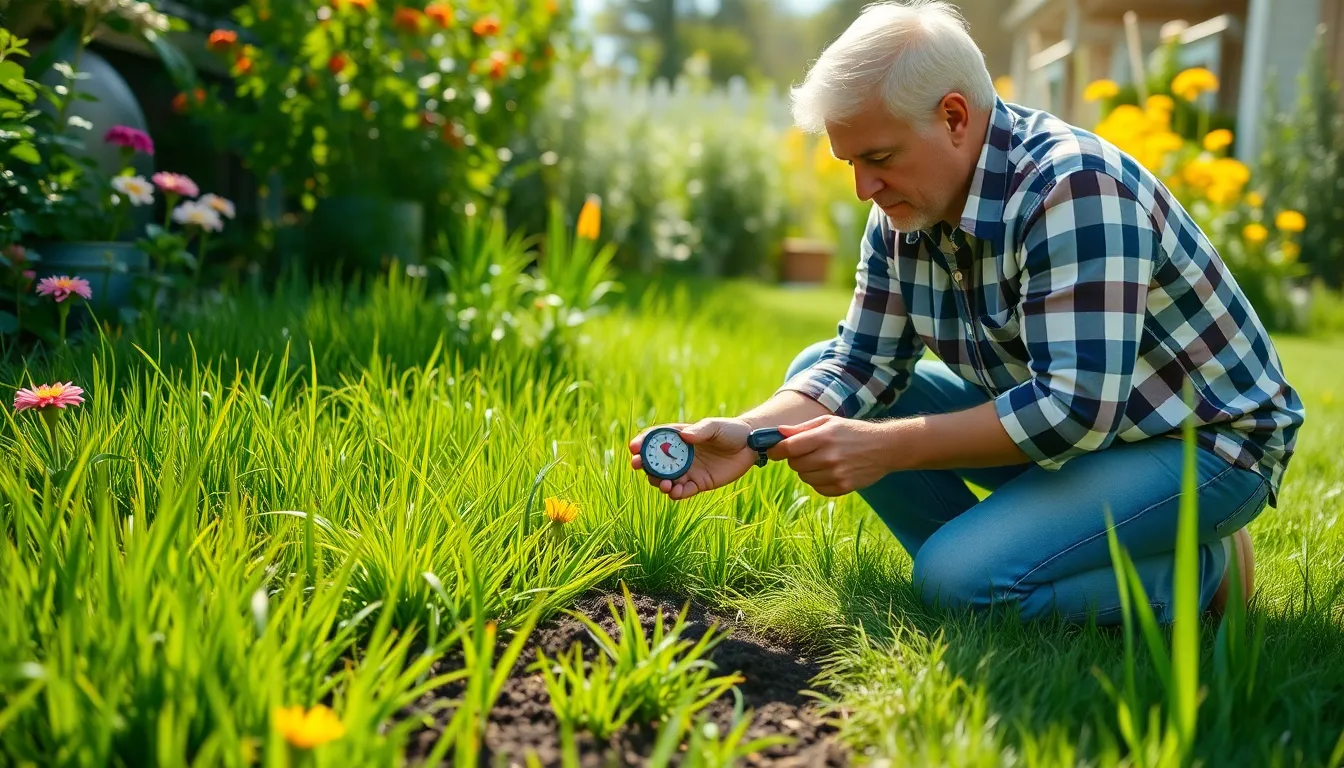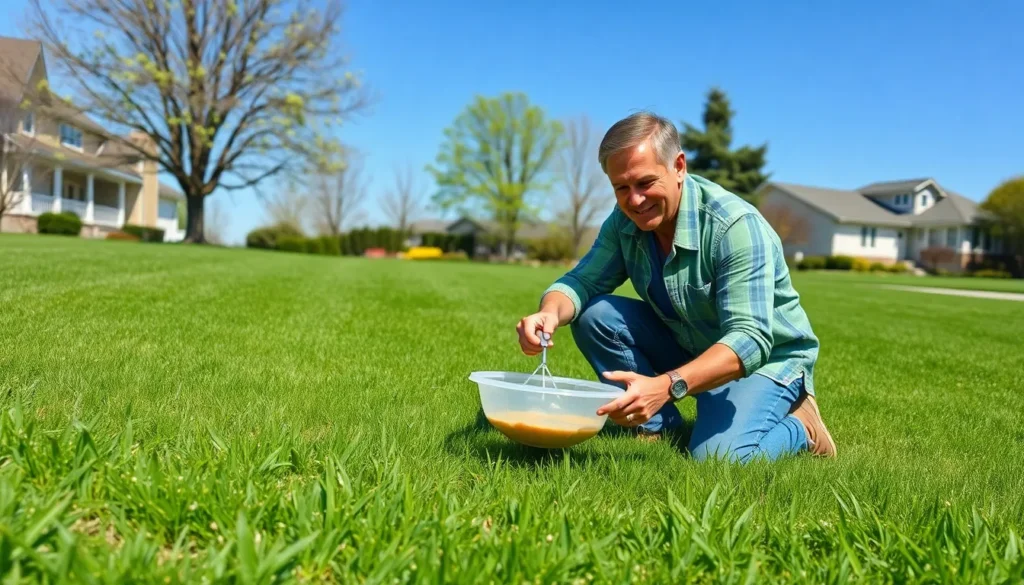Table of Contents
ToggleCrabgrass can quickly overtake a lawn, turning lush green spaces into unsightly patches of weeds. To keep this invasive grass at bay, timing is everything when applying crabgrass preventer. Knowing when to put down this crucial product can make the difference between a thriving lawn and a weed-infested yard.
Typically, the best time to apply crabgrass preventer is in early spring, just before the soil temperatures reach 55°F. This window allows the preventer to establish itself before crabgrass seeds germinate. Understanding local climate patterns and soil temperatures is essential for homeowners aiming to maintain a beautiful, healthy lawn. With the right timing and a little care, it’s possible to keep crabgrass at bay and enjoy a lush green landscape all season long.
Understanding Crabgrass Preventer
Crabgrass preventer, also known as pre-emergent herbicide, prevents crabgrass seeds from germinating. Timing and application methods significantly impact its effectiveness. Applications made too early or too late can reduce efficacy, allowing crabgrass to proliferate.
Homeowners should focus on soil temperatures, as they play a crucial role in germination. Crabgrass seeds start germinating when soil temperatures consistently reach 55°F. Applying crabgrass preventer before this threshold ensures the herbicide interacts with seeds, stopping their growth.
Different formulations of crabgrass preventer exist, including granular and liquid types. Granular products often provide ease of application and extended control, while liquid options deliver quicker absorption. Selecting the right formulation aligns with lawn care strategies and preferences.
Local climatic conditions influence the timing. Regional differences in temperature and precipitation patterns can significantly affect crabgrass emergence. Homeowners benefit from monitoring local weather forecasts and soil conditions to optimize application timing.
Correct application techniques enhance the effectiveness of crabgrass preventer. Even distribution over the lawn ensures coverage of all areas, minimizing gaps where crabgrass may germinate. Calibration of spreaders and adherence to product instructions improves results.
Understanding these factors contributes to the success of crabgrass prevention efforts, maintaining a healthy and vibrant lawn throughout the growing season.
When To Put Down Crabgrass Preventer

Timing plays a critical role in successfully applying crabgrass preventer. Homeowners should focus on early spring when soil temperatures reach 55°F for optimal results.
Ideal Timing Based on Climate
Ideal timing for applying crabgrass preventer depends on local climate conditions. Homeowners in warmer regions may need to apply the preventer as early as late February to early March, while those in cooler areas might wait until mid-April. Regular monitoring of soil temperatures ensures timely application. Using a soil thermometer can provide accurate readings, indicating when to apply the herbicide effectively.
Regional Variations in Timing
Regional variations affect the ideal application time for crabgrass preventer. Areas with distinct seasonal changes experience different germination times for crabgrass seeds.
| Region | Ideal Application Time |
|---|---|
| Northern States | Mid to late April |
| Mid-Atlantic | Early to mid-April |
| Southern States | Late February to early March |
| Pacific Northwest | Mid to late March |
Understanding these regional differences allows homeowners to tailor their approach and enhance the effectiveness of crabgrass prevention. Applying too early or too late reduces the preventer’s efficacy, allowing crabgrass to thrive.
Methods of Application
Applying crabgrass preventer correctly maximizes its effectiveness. Two primary methods exist: spraying and spreading.
Spraying vs. Spreading
Spraying involves applying liquid formulations of crabgrass preventer. This method allows for precise application and coverage on uneven surfaces, ensuring that hard-to-reach areas are adequately treated. Conversely, spreading typically employs granular formulations. Spreaders distribute granules evenly across the lawn, targeting larger areas quickly. The choice between these methods depends on lawn size and terrain. Spraying suits smaller or oddly shaped lawns, while spreading works best for expansive, flat areas.
Best Practices for Effective Coverage
Achieving effective coverage requires the following best practices:
- Calibrate Equipment: Ensuring sprayers or spreaders operate correctly ensures an even distribution of the herbicide. Calibration minimizes waste and increases impact.
- Check Weather Conditions: Applying the preventer before rain helps with absorption, but avoid application during heavy rain to prevent runoff.
- Apply on Dry Surfaces: Dry grass and soil promote better adherence of the herbicide.
- Follow Product Instructions: Adhering to the manufacturer’s guidelines provides accurate dosage recommendations and optimal application techniques.
- Overlap Passes: Overlapping each pass with spreaders or sprayers guarantees complete coverage, preventing gaps where crabgrass could thrive.
Implementing these best practices enhances the effectiveness of crabgrass preventer, improving lawn health throughout the growing season.
Tips for Success
Proper preparation and follow-up care significantly enhance the effectiveness of crabgrass preventer applications. Homeowners must take proactive steps to ensure a robust lawn and minimize crabgrass growth.
Preparing Your Lawn
Preparing the lawn before applying crabgrass preventer is essential for optimal results.
- Mow the Lawn: Mowing grass to a short height encourages the preventer to reach the soil easily. This increases its contact with potential crabgrass seeds.
- Rake Debris: Raking removes leaves, twigs, and clippings, preventing them from blocking the preventer from reaching the soil.
- Aerate the Soil: Aerating helps improve soil quality and allows effective penetration of the preventer.
- Moisten the Soil: Lightly watering the lawn before application can enhance how the product adheres to soil and allows for better absorption once applied.
- Check Soil Temperature: Use a soil thermometer to ensure temperatures are at or approaching 55°F for maximum effectiveness.
Follow-Up Care
Follow-up care plays a crucial role in lawn health post-application.
- Watering Schedule: Following application, lightly watering the lawn activates the crabgrass preventer, initiating its effectiveness. Avoid heavy watering that can wash the product away.
- Monitor Lawn Condition: Regularly assess lawn health for crabgrass emergence despite using a preventer. Early detection allows for quick remediation.
- Limit Disturbance: Avoid reseeding or heavy foot traffic on treated areas to maintain effectiveness.
- Observe Timing for Reseeding: If reseeding is necessary, wait the recommended time (usually 2-3 months) after applying the preventer to ensure successful seed germination.
- Fertilization: Following the product guidelines for fertilization helps the lawn recover and thrive, ensuring a lush appearance throughout the growing season.
Timing is crucial when applying crabgrass preventer to ensure a healthy lawn. By understanding local climate patterns and soil temperatures homeowners can effectively prevent crabgrass from taking root. Early spring applications just before soil temperatures reach 55°F are essential for optimal results.
Utilizing the right application techniques and formulations further enhances the effectiveness of the preventer. With proper preparation and follow-up care homeowners can enjoy a vibrant lawn free from crabgrass. By staying informed and proactive they can maintain their landscapes throughout the growing season.







